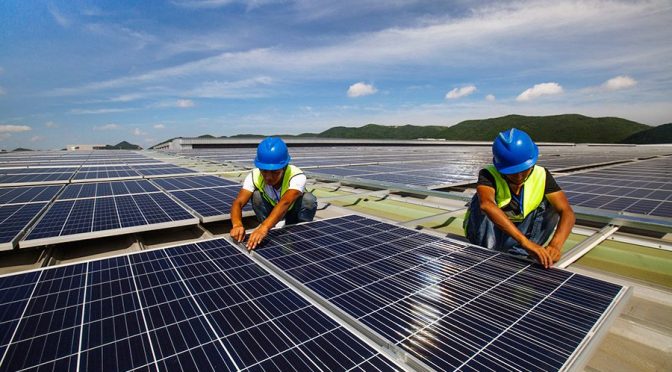In recent years, China has emerged as a global leader in renewable energy, setting determined goals and accomplishing extraordinary milestones. As the world grapples with the urgent need to shift towards sustainable energy sources, China’s efforts in renewable energy serve as a model for other nations.
China set a target of decarbonization and to become a top in renewable energy in the early 2000s, propelled by a trifecta of factors: economic potential, energy security, and environmental concerns. Realizing the necessity of a sustainable future, the Chinese government has introduced a number of laws and incentives to encourage the growth of renewable energy sources.
The 13th Five-Year Plan (2016-20) marked a critical turning point in China’s renewable energy path by establishing ambitious goals for wind, solar and hydropower. China installed more than 530 gigawatts (GW) of renewable energy capacity by the end of 2020, making up approximately 30 percent of the world’s total renewable energy. China now hopes to reach carbon neutrality by 2060 and peak carbon emissions by 2030, propelled by the momentum from this remarkable growth.
China has led the world in promoting renewable energy, with solar power leading the way. As of 2023, the nation had an astounding 253 GW of installed solar capacity, making it the greatest producer and consumer of solar panels worldwide. Government subsidies, technological developments, and economies of scale that have lowered the price of solar energy have all contributed to the industry’s explosive growth.
The construction of massive solar farms, like the 1.5 GW Tengger Desert Solar Park, which covers an area of more than 1,200 square kilometers, is an example of China’s solar power success story. To fully utilize this renewable resource, the nation has also been investing in cutting-edge solar technologies such as solar-powered desalination plants and floating solar farms.
Another essential component of China’s renewable energy policy is wind power. China has grown to be the world’s largest market for wind power due to its abundant wind resources, especially in the northern and western areas. By the end of 2023, the nation had installed more than 300 GW of wind capacity, exceeding its 2020 objective and establishing new yearly installations records in the process.
With projects like the Jiangsu Rudong Offshore Wind Farm adding to China’s mix of renewable energy sources, the development of offshore wind farms has also accelerated. Offshore wind is an essential part of China’s energy transition since it has many benefits, such as less land use conflicts and higher wind speeds.
China’s energy landscape has long included hydropower, which offers a dependable and low-carbon source of electricity. Some of the biggest hydroelectric projects in the world, such as the 22.5 GW Three Gorges Dam, are located in China. Approximately 18 percent of China’s total electricity generation as of 2023 came from hydropower.
Although hydropower has many advantages, there are drawbacks as well, including effects on the environment and community dislocation. It is a challenging endeavor that calls for careful planning and stakeholder participation to strike a balance between these concerns and the demand for clean energy.
The integration of renewable energy into the national grid is one of the main challenges China’s renewable energy sector faces, despite its impressive accomplishments. Because solar and wind power are intermittent, advanced grid management and energy storage solutions are necessary to ensure a steady and reliable supply of electricity.
Power-to-gas, lithium-ion batteries, and pumped hydro storage are three examples of energy storage technologies that are essential to meeting this challenge. With the intention of building 30 GW of storage capacity by 2025, China has been making significant investments in energy storage. Optimizing the use of renewable energy and boosting grid resilience will also be greatly aided by the development of smart grids and digital technology.
The requirement to gradually phase out coal-fired power facilities, which still make up a sizable amount of China’s energy mix, presents another difficulty. Although the nation has made headway in cutting back on coal use, a more forceful shift away from fossil fuels will be necessary to reach carbon neutrality. In order to prevent economic disruptions and provide a fair transition for coal industry workers, this shift needs to be handled properly.
China is a leader in renewable energy, which has significant effects on the world energy market. As the largest greenhouse gas emitter in the world, its actions are essential to meeting global climate targets. In addition to lowering its own carbon footprint, the nation sets an example for other countries to follow with its dedication to renewable energy.
Furthermore, China’s renewable energy sector is now a key engine of both employment creation and economic expansion. Today, the nation leads the world in the export of renewable energy technologies, such as batteries, wind turbines and solar panels. China now holds a prominent role in the global renewable energy sector, giving it considerable clout in international climate negotiations.
The renewable energy revolution in China is evidence of the potency of technological innovation, strategic planning and visionary leadership. Even if there are still obstacles to overcome, the nation’s successes with hydropower, wind and solar energy show that a sustainable energy future is achievable. China is serving as an inspiration as it pushes the limits of renewable energy.
China is not just tackling its environmental issues but also laying the foundation for a cleaner, greener and more wealthy future by adopting renewable energy. To guarantee a smooth transition to a sustainable energy system that benefits everyone, the international community must take note of China’s efforts and assist in the cause.
Shah Faisal | chinadaily.com.cn
The author is a PhD student at the School of Electrical Engineering at Southeast University in Nanjing.


